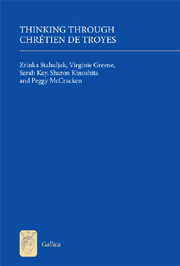Book contents
- Frontmatter
- Contents
- Preface
- Introduction
- 1 The “Changeful Pen”: Paradox, Logical Time, and Poetic Spectrality in the Poems Attributed to Chrétien de Troyes
- 2 Imagination
- 3 Adventures in Wonderland: Between Experience and Knowledge
- 4 Feudal Agency and Female Subjectivity
- 5 Forgetting to Conclude
- Epilogue
- Appendix I Sigla of the Principal Manuscripts of the Chrétien Romances
- Appendix II Lyric Texts, Textual Notes and Translations
- Appendix III Passages from Cligés for Comparison with Lyric Texts
- Appendix IV Variants to the “Cart Scene” in Le Chevalier de la Charrete
- Bibliography
- Index
- Title in the Series
5 - Forgetting to Conclude
Published online by Cambridge University Press: 05 February 2013
- Frontmatter
- Contents
- Preface
- Introduction
- 1 The “Changeful Pen”: Paradox, Logical Time, and Poetic Spectrality in the Poems Attributed to Chrétien de Troyes
- 2 Imagination
- 3 Adventures in Wonderland: Between Experience and Knowledge
- 4 Feudal Agency and Female Subjectivity
- 5 Forgetting to Conclude
- Epilogue
- Appendix I Sigla of the Principal Manuscripts of the Chrétien Romances
- Appendix II Lyric Texts, Textual Notes and Translations
- Appendix III Passages from Cligés for Comparison with Lyric Texts
- Appendix IV Variants to the “Cart Scene” in Le Chevalier de la Charrete
- Bibliography
- Index
- Title in the Series
Summary
The Chrétien romances are long poems, we noted in Chapter 1. The narratives unfold in rhyming couplets, like all twelfth-century romances in Old French, but the chronology of the story is sometimes interrupted by what we've identified as logical time. Like the Chrétien songs, the romances engage in the non-chronological temporality of “thinking on the spot,” the process through which the text thinks using repetition and contradiction. That is, reading the romances in light of the lyric spectrality of the songs suggests the extent to which the chronology of the narratives may give way to logical time, to thinking on the spot. As we have emphasized throughout this book, alongside the linear chronology of the narrative, the Chrétien romances emphasize a temporality outside of strict chronological narrative progression. This is a temporal space of thinking on the spot in which we locate a working-out of what it means to imagine and to think, to move from the experience of adventure to an intersubjective understanding of the event, and to inhabit an identity defined in the nexus of gender, authority, and speech.
The Chrétien œuvre – in its various and variant forms – thinks through and with rhyme and repetition. As we noted in Chapter 1, a rhyme is by definition a return to an earlier sound and is thus implicated in thinking on the spot, the repetitive reprocessing of thought characterized by contradiction and multiplicity. In their return to what came before, rhyme and repetition may also be seen as mechanisms of memory.
- Type
- Chapter
- Information
- Thinking Through Chrétien de Troyes , pp. 139 - 162Publisher: Boydell & BrewerPrint publication year: 2011



